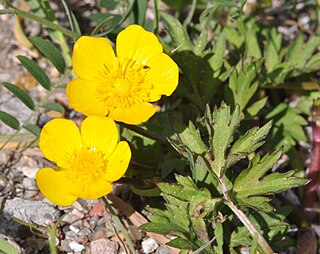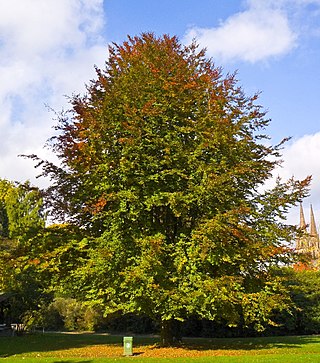
Asterales is an order of dicotyledonous flowering plants that includes the large family Asteraceae known for composite flowers made of florets, and ten families related to the Asteraceae. While asterids in general are characterized by fused petals, composite flowers consisting of many florets create the false appearance of separate petals.

Flowering plants are plants that bear flowers and fruits, and form the clade Angiospermae, commonly called angiosperms. They include all forbs, grasses and grass-like plants, a vast majority of broad-leaved trees, shrubs and vines, and most aquatic plants. The term "angiosperm" is derived from the Greek words ἀγγεῖον / angeion and σπέρμα / sperma ('seed'), meaning that the seeds are enclosed within a fruit. They are by far the most diverse group of land plants with 64 orders, 416 families, approximately 13,000 known genera and 300,000 known species. Angiosperms were formerly called Magnoliophyta.

The Fagaceae are a family of flowering plants that includes beeches, chestnuts and oaks, and comprises eight genera with about 927 species. Fagaceae in temperate regions are mostly deciduous, whereas in the tropics, many species occur as evergreen trees and shrubs. They are characterized by alternate simple leaves with pinnate venation, unisexual flowers in the form of catkins, and fruit in the form of cup-like (cupule) nuts. Their leaves are often lobed, and both petioles and stipules are generally present. Their fruits lack endosperm and lie in a scaly or spiny husk that may or may not enclose the entire nut, which may consist of one to seven seeds. In the oaks, genus Quercus, the fruit is a non-valved nut called an acorn. The husk of the acorn in most oaks only forms a cup in which the nut sits. Other members of the family have fully enclosed nuts. Fagaceae is one of the most ecologically important woody plant families in the Northern Hemisphere, as oaks form the backbone of temperate forest in North America, Europe, and Asia, and are one of the most significant sources of wildlife food.

Heracleum mantegazzianum, commonly known as giant hogweed, is a monocarpic perennial herbaceous plant in the carrot family Apiaceae. H. mantegazzianum is also known as cartwheel-flower, giant cow parsley, giant cow parsnip, or hogsbane. In New Zealand, it is also sometimes called wild parsnip or wild rhubarb.

Floriculture is the study of the efficient production of the plants that produce showy, colorful flowers and foliage for human enjoyment and the human environment. It is a commercially successful branch of horticulture and agriculture found throughout the world. Efficient production practices have been developed over the years, for the hundreds of plant taxa used in the floral industry, increasing the overall knowledge of whole plant biology. Plant breeding and selection have produced tens of thousands of new genotypes for human use.Jasmine, Marigold ,Chrysanthemum, Rose, Orchid, Anthurium etc. are flowers of commercial demand.

Haemodoraceae is a family of perennial herbaceous flowering plants with 14 genera and 102 known species. It is sometimes known as the "bloodroot family". Primarily a Southern Hemisphere family, they are found in South Africa, Australia and New Guinea, and in the Americas. Perhaps the best known are the widely cultivated and unusual kangaroo paws from Australia, of the two closely related genera Anigozanthos and Macropidia.

Plant reproductive morphology is the study of the physical form and structure of those parts of plants directly or indirectly concerned with sexual reproduction.
Photoperiodism is the physiological reaction of organisms to the length of night or a dark period. It occurs in plants and animals. Plant photoperiodism can also be defined as the developmental responses of plants to the relative lengths of light and dark periods. They are classified under three groups according to the photoperiods: short-day plants, long-day plants, and day-neutral plants.

The mustard plant is any one of several plant species in the genera Brassica and Sinapis in the family Brassicaceae. Mustard seed is used as a spice. Grinding and mixing the seeds with water, vinegar, or other liquids creates the yellow condiment known as prepared mustard. The seeds can also be pressed to make mustard oil, and the edible leaves can be eaten as mustard greens. Many vegetables are cultivated varieties of mustard plants; domestication may have begun 6,000 years ago.

Cannabis ruderalis is a variety, subspecies, or species of Cannabis native to Central and Eastern Europe and Russia. It contains a relatively low quantity of psychoactive compound tetrahydrocannabinol (THC) Some scholars accept C. ruderalis as its own species due to its unique traits and phenotypes which distinguish it from C. indica and C. sativa; others debate whether ruderalis is a subdivision under C. sativa.

The Balsaminaceae are a family of dicotyledonous plants, comprising two genera: Impatiens, which consists of over 1000 species, and Hydrocera, consisting of 1 species. The flowering plants may be annual or perennial. They are found throughout temperate and tropical regions, primarily in Asia and Africa, but also North America and Europe.

The Eriocaulaceae are a family of monocotyledonous flowering plants in the order Poales, commonly known as the pipewort family. The family is large, with about 1207 known species described in seven genera. They are widely distributed, with the centers of diversity for the group occurring in tropical regions, particularly the Americas. Very few species extend to temperate regions, with only 16 species in the United States, mostly in the southern states from California to Florida, only two species in Canada, and only one species in Europe. They tend to be associated with wet soils, many growing in shallow water. This is also reported from the southern part of India and the regions of Western Ghats hot spots.

The Cabombaceae are a family of aquatic, herbaceous flowering plants. A common name for its species is water shield. The family is recognised as distinct in the Angiosperm Phylogeny Group IV system (2016). The family consists of two genera of aquatic plants, Brasenia and Cabomba, totalling six species.

Scheuchzeria palustris, is a flowering plant in the family Scheuchzeriaceae, in which there is only one species and Scheuchzeria is the only genus. In the APG II system it is placed in the order Alismatales of the monocots.

The Cyrillaceae are a small family of flowering plants in the order Ericales, native to warm temperate to tropical regions of the Americas. The family comprises two genera, Cliftonia and Cyrilla, each containing a single species, Cliftonia monophylla and Cyrilla racemiflora. However, additional species of Cyrilla are now often recognized and the genus is in need of taxonomic revision.

Staphyleaceae is a small family of flowering plants in the order Crossosomatales, native to Europe, temperate and tropical Asia and the Americas. The largest genus Staphylea, which gives the family its name, contains the "bladdernut" trees. The family includes three genera with more than 40 known species.

Symplocaceae is a family of flowering plants in the order Ericales, including two genera, Symplocos and Cordyloblaste, totalling about 260 known species. The common name for Symplocaceae is sweetleaf. Symplocaceae has a transpacific distribution that covers the Southeast United States, South America, Southeast Asia and Northern Australia. Plants in the family Symplocaceae are generally trees or shrubs, and are found in humid, tropical, montane forests within their range.

Butomus is the only known genus in the plant family Butomaceae, native to Europe and Asia. It is considered invasive in some parts of the United States.

Agave is a genus of monocots native to the hot and arid regions of the Americas and the Caribbean, although some Agave species are also native to tropical areas of North America, such as Mexico. The genus is primarily known for its succulent and xerophytic species that typically form large rosettes of strong, fleshy leaves. Agave now includes species formerly placed in a number of other genera, such as Manfreda, ×Mangave, Polianthes and Prochnyanthes.

Nitrariaceae is a family of flowering plants in the order Sapindales. It comprises four genera, Malacocarpus, Nitraria, Peganum and Tetradiclis, totalling 19 species.


















